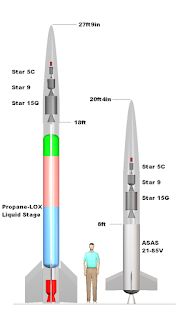Just because I thought it might be worth considering what an all-solids launcher
might look like using high-performance commercial ATK motors, I found what was a
reasonable booster suitable for the first stage. The following diagram shows the
numeric specifications and compares the solid first stage with an equivalent liquid stage. I’ve darkened out the parameters of the upper stages because those things haven’t changed from my last post.
If you look at the image below, one thing that stands out is that the solid booster is physically shorter (for the same diameter) compared to the liquid booster.
This is due to the solid booster's higher average propellant density, which is almost double that of the liquids that I had selected. In actuality, the liquid booster is lighter by about 200 lbs, but it is physically larger because of the lower propellant density.
A summarization of this Comparison
Now, the main impetus of this design experiment was to look at reasonable performance
solids as examples of upper stage vehicles and, then finally, as a first stage booster.
For amateurs to develop these kinds of vehicles, they would have to try to duplicate
the performance factors of these commercial motors with their own designed and fabricated motors. One good thing from this is that they have a known working example and explicit specifications for trying to develop their own versions of the commercial motors. This will simplify the development task somewhat.
Because I went with off-the-shelf motors, their specifications dictated many of the
requirements for the vehicle (such as stage delta V, thrust and mass ratios). In many ways, I consider these designs to be an upper limit of reasonable size for launching a payload as small as a 1/4 pound (113 grams). Think about it: a payload of 1/4 pound required a launcher with a GLOW of 1914 lbs. This is an effective payload:glow ratio of 0.00013 or 0.013 %. This is pretty poor overall. Nonetheless, with smaller launchers we'll see these kinds of ratio values. But we can do better. To do better means that a fundamental ratio between payload and total rocket takeoff mass will be a higher number. Let's examine how to get to smaller, more manageable rockets in upcoming future posts.


As soon as amateurs start thinking big enough they will make it to orbit.
ReplyDeleteAny solid carrying a payload in the 20kg range on a budget is going to look something like the Lamda.
For small tiny payloads like the gram scale you mentioned air launch is the only realistic alternative balloon or aircraft take your pick.
My Team "Team Prometheus" has been working on the air launch "from a balloon" to reach space and possibly put a very small satellite into LEO in the "N-Prize" contest for 3 1/2 years now. The level of interest in realistically orbiting a small payload in that range is just not sufficient enough to get the job done so far. Who cares about the "Prize"? It's about going into space and achieving orbit on a small scale! I don't understand why people think it's so difficult? A very small rocket is all that is required launched from 100kft to achieve space! Much less than is spent trying to achieve that first mark (100kft) from the ground! Van Allen did it way back in the 50's it is the smart money for a cheap space shot bar none! We will do it on March 10th 2012 if we just keep going. By the way thanks alot to all the non supporting members of new space for NOT helping us do what is the only logical thing to do! Idiots. And thanks a lot for all the support you give teams that are just burning money and getting nowhere fast.
Come on guy's how smart do you really need to be to figure this out? Stop trying to reinvent the wheel! It's been done! Just do it! The thinking part has already BEEN DONE! YEARS ago! Mass fraction, Delta V it's all MOOT! Cant you see that? Just build the damn thing! Or why not HELP guy's like me that WILL DO IT.